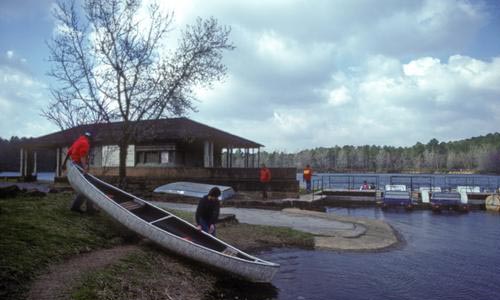Daingerfield State Park "Getting Better All The Time"

Park System Improvements Reflect Support From Voters, Legislature
DAINGERFIELD, Texas Daingerfield State Park has hired a new employee and is renovating three facilities as well as upgrading the park wastewater system and campsite restrooms, thanks to increased funding provided in 2007 by the Texas Legislature and Texas voters.
A new peace officer and interpreter, Craig Johnson, has been hired by the park and conducts regular events for the public, such as nature walks, stargazing, junior ranger programs and educational events.
Theyve been pretty popular, Johnson said. Were doing this for the public, not just tooting our own horn. Its worked out pretty well so far, I think.
Park Superintendent John Thomas agrees. Its been a big plus for usweve gotten a lot of public enthusiasm, and really good public participation.
In addition to the new public programs, planning is underway for a renovation of the parks Bass Lodge, Boat House and Concession Building, which Thomas says should get underway this summer. The renovations will be funded by $2 million in funds that were approved for the parks by Texas voters with Proposition 4 in 2007.
These are all CCC structures that have been in the park from the beginning, and they are in pretty bad shape, Johnson said. We are going to take them down to the base material and rework them.
An update of the parks wastewater system, also made possible through public funding, is also in the planning stages. The update will eliminate the existing septic tank and tie the parks wastewater infrastructure into the cities wastewater system. In the process, camping area restrooms will also be upgraded.
Hopefully, well have a brand-new park to showcase for our 75th anniversary, said Thomas. The park opened in 1938. State investments at Daingerfield State Park should generate a strong return for the host community, since research reported in 2005 showed the park had an annual retail sales impact of about $800,000 from employee and visitor spending, created 17 jobs and produced an impact of $432,319 in additional income for Morris County residents. The numbers come from Texas A&M University research that shows state parks draw outside visitor dollars into host counties.
"The park makes a direct impact on our sales tax from people buying groceries, gasoline, and picnic and camping supplies," said Daingerfield City Manager Marty Byers. "Plus, it allows us to showcase our community to people who might be interested in relocating. Anytime you have an opportunity for people to see a community outside of their own, they might see some positive things and might share that with others and encourage other people to come, and they might shop in town here also."
The A&M study reported that Daingerfield State Park generated $185,979 in revenues and had $261,738 in operating costs in fiscal year 2004. The states "net" investment to operate the park was thus about $76,000. In return, the park generated a retail sales impact of seven times that amount in Morris County from employee and visitor spending on things like groceries, meals out, lodging, shopping and other expenses. If only non-local visitor spending is considered, the park still drew $537,414 in retail sales impact to the host county.
The Daingerfield findings are one example of the data gleaned from interviews conducted with more than 11,000 visitors to Texas state parks in 2002 and 2004 by Texas A&M University professor John Crompton, Ph.D., and his colleagues from the universitys Department of Recreation, Park and Tourism Sciences. The Texas Coalition for Conservation, a nonprofit umbrella group formed to support parks and natural resource conservation, commissioned the research to determine the economic value of state parks. For cost reasons, only 80 state parks were selected for the A&M study. There are currently 93 state parks in Texas.
Research revealed that economic activity associated with the 80 state parks studied generated an estimated total of $793 million in retail sales, had a $456 million impact on residents income and created roughly 11,928 jobs. These figures include spending by all visitors, both local and non-local, plus state park budget dollars spent in local communities. Crompton and his colleagues also analyzed expenditures of park visitors from outside host counties, excluding spending by local residents and "casual" state park visitors attracted to the community for other reasons. For each park studied, the research consistently showed that state parks draw non-local visitors to host counties.
"Tourism is a major component of the Texas economy," Crompton recently told members of the Texas State Parks Advisory Committee in Austin. "Attractions drive tourism and state parks operate more of these desired attractions than any other entity in the state."
Researchers say investing money on facilities upkeep, interpretation and services to enhance the visitor experience can boost the economic value of parks.
"State parks," Crompton contends, "are analogous to retail stores. Economic success depends on what happens inside the facility. Investments in park services and amenities mean more visitors and higher per capital expenditures, which equals higher revenues to the state and more jobs and income for local residents."
The complete "Economic Contributions of Texas State Parks" research report, including fact sheets on each of the 80 parks studied, can be downloaded from the TPWD Web site.
Details on Daingerfield State Park, including visitor facilities, hours and fees, maps and directions, can also be viewed online.
 Texas Parks and Wildlife Department, 4200 Smith School Road, Austin, TX 78744
Texas Parks and Wildlife Department, 4200 Smith School Road, Austin, TX 78744


